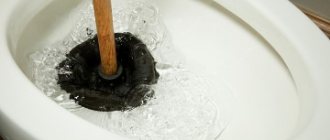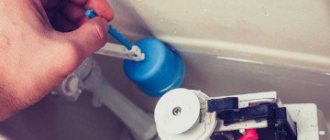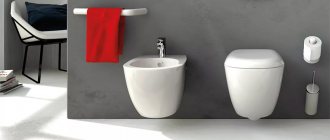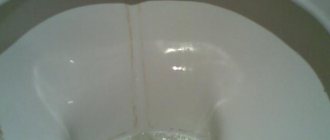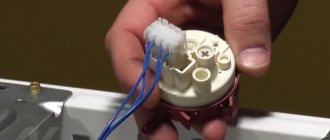Even the most reliable household equipment becomes unusable over time. This also applies to the toilet, which in this case begins to flush poorly. We have to deal with this problem in more detail, find out the reasons for its occurrence, and also find ways to solve this problem. We will carry out all work ourselves without the involvement of specialist plumbers.
Not every one of us knows what to do if the toilet doesn’t flush well.
Tank device
To better understand the essence of the problem, you should familiarize yourself with the principle of operation of the drain tank. This is a container with a small hole in the bottom to drain water into the toilet. Through another hole, located on the side or also at the bottom, the tank is filled.
Internal mechanisms are called fittings, there are two of them:
- float valve for filling . The float is mounted on a lever connected to the valve membrane. Rising with the water level, the float at a certain moment closes the tap. The latter is most often located on the side, in expensive models - at the bottom. In the second case, the collection of water is not accompanied by noise;
- drain mechanism . It consists of a rubber bulb or petal that covers the drain hole and a rod system. By pressing a button or pulling the handle, the user removes the bulb from the saddle and opens the way for water. There are mechanisms with a more complex device: there is a second button to empty the tank halfway, or the ability to stop the drainage of water at any time by pressing the button again (aquastop).
The drain mechanism control is located on the lid or on the side.
The filling tap and drain mechanism are often separated, but there are models with a combined design (they are more expensive).
Cistern with flush valve
Such tanks began to be installed only at the beginning of the 21st century, and therefore they are still relatively rare in home systems.
When you press the flush button, the valve inside rises from its seat and releases water directly into the cistern outlet.
If the device does not flush, it is usually due to a broken part, and in most cases the entire assembly will need to be replaced because individual parts are difficult to find.
If you're lucky, you can buy the same flush module, which will make the repair relatively simple. If you look at the module, you will see that it is possible to rotate its upper, main part of the valve and remove it from the module's support pad. Therefore, by doing this and removing the old module, you can replace the damaged module without dismantling the tank.
Be sure to turn off the water before performing this work.
Why does the toilet start to flush poorly?
Having understood the structure of the device, it is easy to formulate the entire list of reasons for poor flushing:
- the drain hole in the tank is clogged;
- not enough water is collected;
- the annular channel under the rim of the bowl is clogged with deposits (in models with a shower-like circular flush);
- the surface of the bowl has become rough due to natural wear or damage;
- problems with the sewer pipe: incorrect slope, blockage, etc.
The chair must sink
If feces remain in an aqueous environment for a long time, the pores are gradually forced out of its volume. Thus, from objective data one can see that extreme buoyancy was attributed to shit purely from social motivations and allegorical definitions.
Important information is conveyed by the state of our feces in the toilet. It’s worse when the feces sink abruptly, sink to the bottom like a stone, which means the body is heavily polluted, and the intestinal bacteria either don’t work at all or work poorly, they cannot saturate the feces with gases
So periodically pay attention to the condition of your feces in the toilet. By the way, in England I was not the only one who suffered from the fact that the feces refused to be washed off
ALWAYS floated in the toilet. The color, shape, and smell of poop can tell you what's going on in your body. Possibly caused by some kind of infection, in which case diarrhea is the body's way of getting rid of pathogens. BrownIt's okay. Stool is usually brown in color due to bile produced in the liver.
YellowFat, foul-smelling, or bright yellow stool indicates excess fat. This may be due to a fat absorption disorder such as celiac disease. If for the first time you see something wrong in your stool, not the same as usual, do not rush to panic. We all go to the toilet, and although this isn't a dinner party topic, sometimes it's worth taking a look at what we usually try to flush down the toilet as quickly as possible.
As you may have already noticed, the color of your stool can vary depending on the food you eat and other factors. Do you go to the toilet at the same time every morning, or can you go a few days without going much?
Flatulence is embarrassing, but it is the result of harmless bacteria breaking down food in the colon and is a completely healthy process.
Pay attention to the consistency of the stool. Bowel stools should be homogeneous, dense and slightly loose
What should we, amateurs, amateur producers and feces researchers, know about this very product that seems close to us and understandable, but sometimes mysterious? The composition of feces generally depends on the nature of nutrition and the function of the digestive tract. Feces are formed in the large intestine and consist of food debris, mainly plant fiber.
The most efficient drainage systems
Those who are just about to purchase a toilet should think about choosing the type of flush. The most powerful pressure is provided by designs with a high tank, that is, located almost under the ceiling. But due to their unpresentable appearance and loud noise, they are not used in apartments today - only in public toilets.
The currently popular “Compacts” use two types of drainage:
Water from the tank first rushes into the surrounding channel under the rim, then from there it pours into the bowl, so that the whole of it is washed evenly. Such a system is positioned as more effective, but this is a controversial issue. On the one hand, splashes are removed from the entire surface of the bowl and it actually becomes cleaner. But on the other hand, the flow intensity on the rear wall, which is most susceptible to contamination, decreases. The shower drain has one more drawback: if the water quality is low, the channel under the rim quickly becomes clogged with sediment;
soul-shaped (circular).- cascade _ All the water is discharged along the back wall, so that the side and front walls are almost not washed.
Much depends on the shape of the bowl. In visor and funnel-shaped ones, impurities are washed off well, in dish-shaped ones - not always. Therefore, the latter have lost popularity and are found today mainly only in hospitals.
Why doesn't shit wash off?
There are several reasons why shit simply refuses to wash off and continues to float again and again, an eyesore. Each of them has completely different origins.
- Defective toilet cistern. This is one of the reasons why flushing poop becomes a problem. The drain mechanism needs to be checked. It happens that something shifts there, and the water does not flow at full capacity and not quite at the right angle. Because of this, the suction power of the siphon decreases. Here you will have to spend a little time as a plumber or call a specialist to your home. Below we will still give advice on what to do if you are too lazy to do something or simply do not have the money at the moment to repair the holy place. Anything can happen, but the shit needs to be washed off - we’ll get out of it.
- The second reason is directly in you, or rather in the turd that you gave birth to. It has a greasy consistency or is too porous, which helps it stay afloat. In the article about that, you can find out in more detail why poop floats well on water and what degrees of buoyancy poop has.
- There is another reason. But the problem lies not in the fact that it is not possible to flush the poop in the toilet, but in the fact that it becomes clogged, not allowing it to pass. This happens when you put in too much toilet paper. Or they really piled up too big a pile, which cannot be washed off the first time. Usually, on the second try, everything falls into place and the feces are safely sent to visit the Ninja Turtles.
Plumbing cleaning
After turning off the water supply, empty the tank and remove the lid from it.
Lifting the rubber bulb or petal, inspect the drain hole. Sometimes a small part gets into it: a gasket, hardware, a hose put on the nozzle of a filling valve to reduce noise, etc. This is especially likely if the tank is used without a lid.
If the source of the problem is not found during an external inspection, the tank is removed. To do this, unscrew two bolts passing through its bottom and the toilet shelf.
If the hardware does not feed, they are treated with WD-40 aerosol (the best option), kerosene, brake fluid or vinegar. Removing the tank allows you to inspect the drain hole more thoroughly.
Before putting the tank in place, it is strongly recommended to replace the gasket between it and the toilet: if torn out of place, it is unlikely to provide a tight seal for a long time, unless it is a completely new part.
Causes of light stool
The presence of feces on the surface means that they contain a lot of fatty elements.
This aspect depends on improper absorption and subsequent breakdown of fats entering the body with food. The cause is often pathological processes occurring in the digestive system and increased peristalsis. However, the presence of too dense and light stools that cannot be dispersed for a long time is not always a consequence of the disease. They often form as a result of long-term use of medications, in particular antibiotics. If the color of feces changes at the same time, this factor should not be ignored.
Foods that affect stool
Hard, heavy stool with virtually no air pockets can signal that an excessive amount of dangerous toxins has accumulated in the body. Another reason for this change is an increase in cholesterol levels by 1.5 times or more relative to normal.
As for toxins, they come with food or are formed due to excessive consumption of proteins. Products at risk include:
- meat and dairy products;
- eggs;
- bird;
- seafood of dubious origin.
Before using them, careful heat treatment must be carried out. When purchasing, you should also carefully check these products for correctness and shelf life.
If during defecation feces are released, which have a loose structure and do not fall under the water, they are a consequence of eating an unlimited amount of plant foods. Such products contain a lot of fiber, which makes feces fluffy and can color them in unusual shades.
Pathological causes
Why is stool difficult to flush down the toilet? If the cause is the presence of fatty particles in large quantities, this factor should not be ignored, because there is a high probability of pathological changes in the liver.
If the stools are light in color and have a strong and unpleasant odor, the cause may be an intestinal infection. The stool may also contain traces of blood, mucus, and inclusions of an unnatural color.
If a person’s feces are not flushed down the toilet the first time, and the general condition is disturbed, qualified specialist help and treatment will be needed. The first symptoms of a metabolic disorder of fats appear precisely in the unusual state of excrement. More characteristic signs are found in the later stages of the pathology.
Fatty stool that floats to the surface may occur in a small breastfed baby. For babies, this state of affairs is the norm in the first few months of life. The bottom line is the insufficient absorption of fats found in breast milk and accelerated peristalsis.
The toilet cistern drain is clogged
It happens that the clearance of the drain hole decreases due to lime deposits.
Pour 1 liter of water into the tank and resort to dry cleaning using one of the following methods:
- pour 100 g of orthophosphoric acid solution with a concentration of 5%-7%. After a quarter of an hour, wash off with water;
- add borax and vinegar in an amount of 0.5 liters. Wash off after 2 hours;
- dissolve 3-4 sachets of citric acid, wash off after a few hours (can be left overnight).
To remove deposits from the drain hole and from the mechanism parts, it is necessary to repeat chemical cleaning several times in a row. Ultra-effective compounds containing hydrochloric or oxalic acid are not used: they corrode rubber and plastic.
When performing chemical treatment, follow safety precautions: wear rubber gloves and try not to inhale acid fumes.
Preventative measures to combat blockages:
- use of special tablets for water softening: dropped in a container into the tank. The product gradually dissolves, so periodically it is necessary to add a new portion;
- installing a coarse filter (so-called mud filter or oblique filter) on the water supply to the tank.
Preventing toilet blockages
Due to the large diameter of the drainage pipe, toilets become dirty much less frequently than sinks
and baths. If you do not turn the toilet into an analogue of a garbage can, blockages may not form in it for years. Do not flush or throw down the toilet:
- Leftover food
- Personal hygiene items
- Nails
- Hair
- Cat litter
- Cosmetical tools
- Plasters
- Chewing gum
- Tea leaves from a teapot
- Coffee
- Cleaning cloths
- Diapers
If you accidentally end up with things, any objects, or toys in the toilet, put on a rubber yellow household glove and pull them out. Use the toilet only for its intended purpose and this will save you from the lion's share of problems with its clogging.
Sources
- https://partner-tomsk.ru/santehnika/kanalizatsiya/chto-delat-v-sluchae-esli-unitaz-ne-smyivaet-normalno
- https://dekoriko.ru/unitaz/ploho-smyvaet/
- https://Dezoff.ru/kanalizatsiya/ne-ukhodit-voda-v-unitaze/
- https://partner-tomsk.ru/santehnika/kanalizatsiya/chto-delat-v-sluchae-esli-v-unitaze-ne-uhodit-voda-metodyi
[collapse]
Water does not flow into the tank
Modern float valves do not close gradually as the float rises, as was the case before, but abruptly when the tank is filled to the required level. That is, water should flow with good pressure as long as the float is below the maximum mark.
If a thin stream oozes or no water flows at all, consider the following reasons:
- The float valve is clogged, as a result of which water is drawn in very slowly. The tap is cleaned with a thin wire, from time to time supplying water for a second to wash away the destroyed plaque. Act carefully so as not to damage the membrane;
- The water supply line is clogged. This happens with steel water pipes - plastic deposits do not become overgrown. The ideal solution is to replace the pipes.
If the last method is not feasible for any reason, resort to cleaning:
- shut off the water supply;
- the end of the string for hanging curtains is bent into the form of a hook several millimeters in size;
- the second end is bent like the handle of a brace;
- one person rotates the string by the “handle”, the second one feeds it into the pipe, having previously removed the valve (the ball valve can simply be moved to the “open” position).
Having passed the area to the closed valve, place a container under the inlet and open the water with low pressure. In this case, the string is slowly removed from the pipe, continuing to rotate.
Solutions
Once the cause of poor flushing has been identified, it’s time to begin correcting the situation. By the way, sometimes even damaged enamel leads to worse flushing. Therefore, if in doubt, it is worth examining its integrity. Scratches, cracks and chips can trap water and waste, preventing it from flowing down the drain. This problem is relevant for all ceramic plumbing fixtures.
In this case, it would be better to completely replace the toilet. But even if this is not possible, the situation can be resolved. To carry out repair work, you should take ceramic putty or waterproof sealant, powder paint and a gun for applying it. Further actions are as follows.
- Clean and degrease the inside of the bowl. You should first turn off the water and dry the entire toilet, including the tank.
- Use fine-grained sanding paper to clean any chips or other damage.
- Apply putty or sealant to the desired areas.
- Dry the surface . Paint it white.
- Do not use the toilet for its intended purpose until all materials are completely dry. Usually this is 48-72 hours. You should find out the exact information in the instructions or on the packaging.
Such repair work will only temporarily eliminate the problem. However, this may be enough to look for a new toilet. If the appearance of the bowl is completely normal and there is no damage, then the problem lies in the sewer or drainage system. The solution won't take long.
The drain is clogged
This is a fairly common reason for poor toilet drainage. To solve this problem, you should use the following instructions.
- Look under the pear. Perhaps the debris has accumulated there and can be easily removed.
- If the blockage is visible, but it is impossible to pull it out by hand, then turn off the water supply and take tweezers with a flashlight. There is a chance that you can get a foreign object without disassembling the toilet. It is worth noting that the blockage under the pear is the most common and can be easily eliminated.
- If the problem is not visible in the tank or you still can’t get it out, then you will have to disassemble the toilet . To do this, unscrew the bolts between the tank and the shelf and remove the upper part. Remove debris or clean it if there is plaque involved. Assemble the toilet.
In some models, the tank has a separate shelf. Then it makes sense to unscrew the fastenings between it and the bowl. This will give you maximum access to the flushing system. It is worth noting that with this option you will have to replace the cuff under the shelf with a new one. During operation, it becomes less elastic and simply breaks during disassembly.
The toilet cistern drain is clogged
| Circumstance |
|
| Solution |
|
Tip: a closed lid of the flush container reduces the amount of evaporation in the toilet and does not make the air space in it more damp; moreover, it is also an aesthetic component of the room.
The volume of the tank does not increase
Fixing a tank leak can be difficult, especially if the problem lies in the design itself. But some actions can still be taken.
- If the bulb seat is clogged and it does not completely block the flow of water, then it is enough to clean it. After simple manipulations everything will return to normal.
- It happens that the pear loses its elasticity or breaks during use. In this case, you need to buy a new one and replace it. Such a thing is inexpensive, and replacing it will not cause difficulties.
- If the steel or plastic bolts inside the tank itself are broken, then water will penetrate into the shelf through the resulting gaps. Here you will have to decide according to the situation. Sometimes you can find and replace the bolts.
In particularly unfortunate cases, it is necessary to dismantle the entire set of fittings.
Water does not enter the tank
Here, too, you will have to start from the nature of the problem. If the blockage is due to plaque, then you just need to clean the valve. This is achieved by the following steps.
- Turn off the water only to the toilet tank.
- Take out the hairpin. It serves as a lock for the float lever in the valve.
- Clean the nozzle with a small flexible wire. You can also use a knitting needle, but the process will take longer.
- As a result, the part should be completely clean.
- Open the tank valve for literally 1 second. This way the water will remove the remaining small debris.
- Assemble the valve, turn on the water and check the quality of the drain.
If debris gets into the drain, you will have to spend a little more time. Experts recommend using the instructions described below.
- Shut off the water to the entire apartment.
- Unscrew the flexible hose connected to the tank.
- Remove the valve that shuts off the water supply to the tank. If there is a ball option that blocks the water by turning the flag, then everything is simple. It is enough to open it to the maximum to dismantle it.
- Now you have to make a device for cleaning pipes. Steel string for curtains is an ideal option. On one side you need to make a hook, on the other - something like a handle. With the help of the resulting tool, you can comfortably grab and pull out debris.
- It happens that the string simply passes by the supposed blockage. You should place something under the drain valve and turn on the water supply for literally 1 second. Most likely, it will gush and stop immediately. In this case, you need to continue to move the string at the site of the blockage. The water will flow and force out the debris.
It is worth paying attention that pipes made of metal-plastic and polymer do not become clogged. With such a sewer system, this is definitely not the reason for poor flushing. If a blockage does occur, then it is definitely within the toilet in the apartment. Pipes like these make life much easier.
The tank is leaking
Also, water may not be collected due to the fact that it flows into the drain hole without permission.
There may be three reasons:
- The rubber from which the valve that closes the hole is made (pear or petal) has lost its elasticity due to natural aging. The part is replaced with a new one;
- the valve does not fit tightly to the seat due to deposits. Methods for removing deposits are described above;
- The drain mechanism rods are jammed or it is damaged. In the first case, the rods are adjusted, in the second, the mechanism is changed.
The chair must sink
If feces remain in an aqueous environment for a long time, the pores are gradually forced out of its volume. Thus, from objective data one can see that extreme buoyancy was attributed to shit purely from social motivations and allegorical definitions.
Important information is conveyed by the state of our feces in the toilet. It’s worse when the feces sink abruptly, sink to the bottom like a stone, which means the body is heavily polluted, and the intestinal bacteria either don’t work at all or work poorly, they cannot saturate the feces with gases
So periodically pay attention to the condition of your feces in the toilet. By the way, in England I was not the only one who suffered from the fact that the feces refused to be washed off
ALWAYS floated in the toilet. The color, shape, and smell of poop can tell you what's going on in your body. Possibly caused by some kind of infection, in which case diarrhea is the body's way of getting rid of pathogens. BrownIt's okay. Stool is usually brown in color due to bile produced in the liver.
YellowFat, foul-smelling, or bright yellow stool indicates excess fat. This may be due to a fat absorption disorder such as celiac disease. If for the first time you see something wrong in your stool, not the same as usual, do not rush to panic. We all go to the toilet, and although this isn't a dinner party topic, sometimes it's worth taking a look at what we usually try to flush down the toilet as quickly as possible.
As you may have already noticed, the color of your stool can vary depending on the food you eat and other factors. Do you go to the toilet at the same time every morning, or can you go a few days without going much?
Flatulence is embarrassing, but it is the result of harmless bacteria breaking down food in the colon and is a completely healthy process.
Pay attention to the consistency of the stool. Bowel stools should be homogeneous, dense and slightly loose
What should we, amateurs, amateur producers and feces researchers, know about this very product that seems close to us and understandable, but sometimes mysterious? The composition of feces generally depends on the nature of nutrition and the function of the digestive tract. Feces are formed in the large intestine and consist of food debris, mainly plant fiber.
Damage to enamel
Ceramic toilets, which are the most common, are coated with a smooth glaze or enamel. Over time, the coating wears out, and when struck by carelessness, scratches, chips and cracks remain on it. As a result, the smooth surface turns into a rough one and begins to resist the flushing of sewage.
to the enamel is a sure sign that it is time to purchase a new toilet, but if it is not possible to do this yet, they resort to temporary restoration:
- After rinsing and drying the toilet, rough areas are treated with fine-grained sandpaper;
- thoroughly wash the toilet so that no dust remains, then dry and degrease;
- waterproof sealant or ceramic putty is applied to problem areas;
- after waiting for the mixture to dry completely, paint the treated areas with powder paint using a paint gun;
- wait for the paint to dry completely (about 3 days are required) and resume operation of the device.
The improvised glaze does not last long, so it is recommended to plan to purchase a new toilet in the near future.
How many times do they go to the toilet?
The norm for bowel movement is one full trip to the toilet per day, when a person feels not partial, but complete bowel movement. Sometimes there is more frequent bowel movements. Often bowel movements occur 2-3 times a day. This suggests that the person's metabolism is faster or that they have consumed food that has a natural laxative effect. More frequent bowel movements (more than 3 times a day) indicate that you are experiencing diarrhea, which we will discuss below.
There is an opinion that it is normal to have a bowel movement every couple of days, but this is a controversial issue. Emptying your bowels is the body's best way to get rid of toxins, acids and other unnecessary substances that may be building up inside, so ideally this process should happen daily.
Water is retained in the bowl
If the tank works perfectly, but water fills into the toilet and slowly leaves, the problem is a clogged sewer.
There are three ways to clean drains:
- using a plunger through the drain hole of a nearby sink or bathtub. If the blockage is weak, the pressure applied by the plunger will move it out of place;
- plumbing cable. They act in the same way as with a string when cleaning a water pipe: they rotate the cable while simultaneously feeding it into the sewer;
- chemical means. Modern compositions based on acids and alkalis effectively corrode even the most resistant corks. One of the most popular is “Mole”. These products are caustic, so you must follow safety precautions and act strictly according to the instructions.
In private homes, the causes of frequent sewer blockages may be:
- use of small diameter pipes. The minimum diameter of pipes after the toilet is 100 mm;
- incorrect pipe slope. The source of problems is either insufficient slope or excessive slope. In the second case, the water runs off too quickly, not having time to carry the solid fractions with it, and they remain in the pipe. The amount of slope depends on the diameter of the pipe. For products DN100 it is 0.02 (2 cm per meter). The minimum permissible slope for such pipes is 0.012 (1.2 cm per meter);
- a significant distance from the toilet to the riser. According to the standards, it cannot exceed 1 m;
- lack of a vent pipe. This is the top of the riser, brought out through the roof. Provides communication between the internal space of the sewer system and the atmosphere, so that when a large amount of water moves in the pipes, a vacuum is not created. If an air valve is installed instead of a drain pipe, gas pressure may back up the drains from the toilet, causing them to move more slowly.
Air valves can be installed if there is at least one drain pipe in the system.
What to do
If you believe the clog is in the trap or outlet, you can try using a plunger or plumbing cable to remove it.
plunger
For use in a toilet, you need a plunger of a larger diameter than for sinks, since the cross-section of the pipe is much wider. If you don’t have a plunger and are just planning to buy one, you can choose a model with replaceable nozzles or an automatic device, where the pneumatic shock is created not with the help of your force, but mechanically.
How to use a classic plunger:
- Place the plunger against the toilet drain hole and make sure that it fits snugly against the surface; the device should create a vacuum inside the pipe.
- Make several back-and-forth movements.
- Pull the plunger towards you.
- Repeat.
Ideally, after the first flush in the toilet water, you will see pieces of dirt that have clogged the drain. They need to be pulled out with gloved hands and thrown into a pre-prepared garbage bag.
Plumbing cable
The plumbing cable is suitable for cleaning any sewer pipes in the house, including toilets.
- Unwind the cable completely.
- Start immersing it in the water and carefully push it inside the pipe, changing direction.
- Once you have pushed the cable deep enough, slowly pull it out.
- Remove any dirt remaining on it and throw it into a pre-prepared trash bag.
These steps must be repeated 3–5 times until the cable begins to come out clean, without large pieces of dirt.
After using the plunger and/or cable, drain the water to check its current and, if everything is in order, use a special pipe cleaner, such as:
- Domestos for blockages
- Sanfor
- Mole
- Tiret
- Deboucher
They will help dissolve and remove remaining contaminants on the pipe walls.
Due to the large diameter of the pipes, cables with a brush at the end are well suited for toilets.
Causes and manifestations
The source of troubles with a toilet - poor flushing - can be either breakdowns or an unsuccessful design of the bowl or drain system, and in a private house it can also be errors in planning the sewerage system. Let's take a closer look at what can lead to poor flushing and how it manifests itself.
- A blockage in the toilet siphon or sewer pipe. In this case, the water will remain in the toilet bowl or drain very slowly.
- There is not enough water in the tank. When rinsing, you can even visually see that there is very little water. Sometimes water from the tank does not stop flowing.
- The drainage channels in the tank or toilet are clogged. Water flows from the tank slowly, without pressure.
- The design of the bowl or drain does not allow for good rinsing.
- The enamel covering the inside of the bowl is damaged. In this case, it will be clear that the surface is no longer smooth.
- If there is no drain riser in a private house, an air lock forms in the sewer pipe. In this case, the water can leave slowly and evenly or in jerks - at first it stands, and after a while it quickly leaves.
Having found out the cause, you can move on to eliminating it. Let's look at what needs to be done in each case.
Why doesn't shit wash off?
There are several reasons why shit simply refuses to wash off and continues to float again and again, an eyesore. Each of them has completely different origins.
- Defective toilet cistern. This is one of the reasons why flushing poop becomes a problem. The drain mechanism needs to be checked. It happens that something shifts there, and the water does not flow at full capacity and not quite at the right angle. Because of this, the suction power of the siphon decreases. Here you will have to spend a little time as a plumber or call a specialist to your home. Below we will still give advice on what to do if you are too lazy to do something or simply do not have the money at the moment to repair the holy place. Anything can happen, but the shit needs to be washed off - we’ll get out of it.
- The second reason is directly in you, or rather in the turd that you gave birth to. It has a greasy consistency or is too porous, which helps it stay afloat. In the article about that, you can find out in more detail why poop floats well on water and what degrees of buoyancy poop has.
- There is another reason. But the problem lies not in the fact that it is not possible to flush the poop in the toilet, but in the fact that it becomes clogged, not allowing it to pass. This happens when you put in too much toilet paper. Or they really piled up too big a pile, which cannot be washed off the first time. Usually, on the second try, everything falls into place and the feces are safely sent to visit the Ninja Turtles.
Choosing a new toilet
Which toilet flushes better?
What should you pay attention to when choosing a new set of plumbing fixtures?
- Tank location . The upper tank always flushes much better than the lower one. Cause? What do you think, which column of water will give more pressure: twenty centimeters or one and a half meters?
The upper tank gives more water pressure and better flushing
- Paradoxically, a toilet with a circular flush , in which water pours into the bowl from all sides, does not flush well. It’s paradoxical - because these toilets are the most popular. Yes, jets of water around the circumference wash the bowl without leaving splashes or other debris on it. However, less water is used to flush the most dirty back of the bowl. If so, it is purified worse.
- The visor inside the bowl makes flushing noticeably more efficient . Both paper and other contents of the toilet sink quickly. However, this toilet has an unpleasant drawback - the smell. Until flushing, the products from the toilet lie on the canopy and, frankly speaking, do not ozone the air.
This bowl shape is not ideal, but provides excellent flushing
- How well a bowl is cleaned when flushed is greatly influenced by its material . Porcelain toilets are ideal in this sense. They have a very smooth surface with almost no pores. Glazed earthenware, however, is not far behind.

